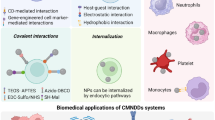Abstract
Monocyte-based gene therapies in cancer have been hampered by either the resistance of these cells to non-viral molecular delivery methods or their poor trafficking to the tumor site after their ex vivo manipulations. Magnetic nanoparticles (MNP)-loaded genetically engineered monocytes can efficiently delivered to tumor site by external magnetic field, but they are not ideal delivery tools due to their spherical shape. Hence, we have investigated the cellular uptake efficiency and cytotoxicity of fluorescein isothiocyanate (FITC)-labelled magnetic carbon nanotubes (FITC-mCNT) in human monocytic leukemia cell line THP-1 for application in cell-based gene therapy against cancer. Uptake of FITC-mCNT into THP-1 cells reached 100% only 1 h after the delivery. Confocal imaging confirmed that FITC-mCNT entered the cell cytoplasm and even into the nucleus. FITC-mCNT uptake did not compromise cell viability. This delivery system might therefore enhance cell-based cancer gene therapies.


Similar content being viewed by others
References
Andreesen R, Hennemann B, Krause SW (1998) Adoptive immunotherapy of cancer using monocyte-derived macrophages: rationale, current status, and perspectives. J Leukoc Biol 64:419–426
Bambacioni F, Casati C, Serafini M, Manganini M, Golay J, Introna M (2001) Lentiviral vectors show dramatically increased efficiency of transduction of human leukemic cell Lines. Haematologica 86:1095–1096
Beduneau A, Ma Z, Grotepas CB, Kabanov A, Rabinow BE, Gong N, Mosley RL, Dou H, Boska MD, Gendelman HE (2009) Facilitated monocyte-macrophage uptake and tissue distribution od supermagnetic iron-oxide nanparticles. PloS One 4:e4343
Cai D, Mataraza JM, Qin ZH, Huang Z, Huang J, Chiles TC, Carnahan D, Kempa K, Ren Z (2005) Highly efficient molecular delivery into mammalian cells using carbon nanotube spearing. Nat Methods 2:449–454
Daldrup-Link HE, Rudelius M, Oostendorp RA, Jacobs VR, Simon GH, Gooding C, Rummeny EJ (2005) Comparison of iron oxide labeling properties of hematopoietic progenitor cells from cord blood and from peripheral blood for subsequent in vivo tracking in a xenotransplant mouse model. Acad Radiol 12:502–510
Dresselhaus MS, Dresselhaus G, Jorio A (2004) Unusual properties and structure of carbon nanotubes. Annu Rev Mater Res 34:247–278
Ferreira L, Karp JM, Nobre L, Langer R (2008) New opportunities: the use of nanotechnologies to manipulate and track stem cells. Cell Stem Cell 3:136–146
Gul H, Lu W, Xu P, Xing J, Chen J (2010) Magnetic carbon nanotube labelling for haematopoietic stem/progenitor cell tracking. Nanotechnology 21:155101
Kusumawati A, Commes T, Liautard JP, Widada JS (1999) Transfection of myelomonocytic cell lines: cellular response to a lipid-based reagent and electroporation. Anal Biochem 269:219–221
Leek RD, Landers RJ, Harris AL, Lewis CE (1999) Necrosis correlates with high vascular density and focal macrophage infiltration in invasive carcinoma of the breast. Br J Cancer 79:991–995
Lübbe AS, Bergemann C, Riess H, Schriever F, Reichardt P et al (1996) Clinical experiences with magnetic drug targeting: a phase I study with 4′-epidoxorubicin in 14 patients with advanced solid tumors. Cancer Res 56:4686–4693
Lübbe AS, Alexiou C, Bergemann C (2001) Clinical applications of magnetic drug targeting. J Surg Res 95:200–206
McBain SC, Yiu HH, Dobson J (2008) Magnetic nanoparticles for gene and drug delivery. Int J Nanomedicine 3:169–180
Mooney E, Dockery P, Greiser U, Murphy M, Barron V (2008) Carbon nanotubes and mesenchymal stem cells: biocompatibility, proliferation and differentiation. Nano Lett 8:2137–2143
Muthana M, Scott SD, Farrow N, Morrow F, Murdoch C, Grubb S, Brown N, Dobson J, Lewis CE (2008) A novel magnetic approach to enhance the efficacy of cell-based gene therapies. Gene Ther 15:902–910
Papapetrou EP, Zoumbos NC, Athanassiadou A (2005) Genetic modification of hematopoietic stem cells with nonviral systems: past progress and future prospects. Gene Ther 12:118–130
Parihar A, Eubank TD, Doseff AI (2010) Monocytes and macrophages regulate immunity through dynamic networks of survival and cell death. J Innate Immun 2:204–215
Schnoor M, Buers I, Sietmann A, Brodde MF, Hofnagel O, Robenek H, Lorkowski S (2009) Efficient non-viral transfection of THP-1 cells. J Immunol Methods 344:109–115
Settles M, Etzrodt M, Kosanke K, Schiemann M, Zimmermann A, Meier R, Braren R, Huber A, Rummeny EJ, Weissleder R, Swirski FK, Wildgruber M (2011) Different capacity of monocyte subsets to phagocytose iron-oxide nanoparticles. PloS One 6:e25197
Sobik M, Pondman KM, Erné B, Kuipers B, ten Haken B, Rogalla H (2011) Magnetic nanoparticles for diagnosis and medical therapy. In: Klingeler R, Sim RB (eds) Carbon nanotubes for biomedical applications. Springer-Verlag, Berlin, pp 85–95
Acknowledgments
The authors would like to acknowledge funding support from the Natural Sciences and Engineering Research Council (NSERC) and Canadian Institutes of Health Research (CIHR) joint CHRP grant 365569-09.
Author information
Authors and Affiliations
Corresponding author
Rights and permissions
About this article
Cite this article
Gul-Uludag, H., Lu, W., Xu, P. et al. Efficient and rapid uptake of magnetic carbon nanotubes into human monocytic cells: implications for cell-based cancer gene therapy. Biotechnol Lett 34, 989–993 (2012). https://doi.org/10.1007/s10529-012-0858-y
Received:
Accepted:
Published:
Issue Date:
DOI: https://doi.org/10.1007/s10529-012-0858-y




